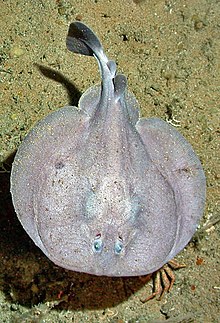Atlantic torpedo
| Atlantic torpedo | |
|---|---|
 |
|
| Scientific classification | |
| Kingdom: | Animalia |
| Phylum: | Chordata |
| Class: | Chondrichthyes |
| Subclass: | Elasmobranchii |
| Order: | Torpediniformes |
| Family: | Torpedinidae |
| Genus: | Tetronarce |
| Species: | T. nobiliana |
| Binomial name | |
|
Tetronarce nobiliana Bonaparte, 1835 |
|
 |
|
| Range of the Atlantic torpedo | |
| Synonyms | |
|
Torpedo emarginata M'Coy, 1841 |
|
Torpedo emarginata M'Coy, 1841
Torpedo hebetans Lowe, 1838
Torpedo nigra Guichenot, 1850
Torpedo nobiliana Bonaparte, 1835
Torpedo occidentalis Storer, 1843
Torpedo walshii Thompson, 1856
Atlantic torpedo (Tetronarce nobiliana) is a species of electric ray in the family Torpedinidae. It is found in the Atlantic Ocean, from Nova Scotia to Brazil in the west and from Scotland to West Africa and off southern Africa in the east, occurring at depths of up to 800 m (2,600 ft). Younger individuals generally inhabit shallower, sandy or muddy habitats, whereas adults are more pelagic in nature and frequent open water. Up to 1.8 m (6 ft) long and weighing 90 kg (200 lb), the Atlantic torpedo is the largest known electric ray. Like other members of its genus, it has an almost circular pectoral fin disk with a nearly straight leading margin, and a robust tail with a large triangular caudal fin. Distinctive characteristics include its uniform dark color, smooth-rimmed spiracles (paired respiratory openings behind the eyes), and two dorsal fins of unequal size.
Solitary and nocturnal, the Atlantic torpedo is capable of generating up to 220 volts of electricity to subdue its prey or defend itself against predators. Its diet consists mainly of bony fishes, though it also feeds on small sharks and crustaceans. It is an aplacental viviparous species, wherein the developing embryos are nourished by yolk and later maternally provided histotroph ("uterine milk"). Females give birth to up to 60 young following a gestation period of one year. The electric shock of this species can be quite severe and painful, though it is not fatal. Because of its electrogenic properties, the Atlantic torpedo was used in medicine by the Ancient Greeks and Romans and became the namesake of the naval weapon. Prior to the 19th century, its liver oil was used as lamp fuel, but it is no longer of any economic value. The International Union for Conservation of Nature (IUCN) has listed this species as Data Deficient; it is caught unintentionally by commercial and recreational fishers, but the impact of these activities on its population is unknown.
...
Wikipedia

